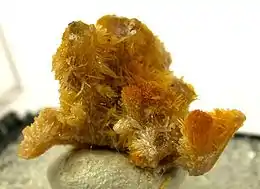Boltwoodite
Boltwoodite is a hydrated uranyl silicate mineral with formula (K0.56Na0.42)[(UO2)(SiO3OH)]·1.5(H2O), distinct in crystal structure from sodium boltwoodite, which has an orthorhombic structure rather than monoclinic.[7] It is formed from the oxidation and alteration of primary uranium ores. It takes the form of a crust on some sandstones that bear uranium. These crusts tend to be yellowish with a silky or vitreous luster.[5][8]
| Boltwoodite | |
|---|---|
 Acicular crystals of umber-yellow boltwoodite from Namibia (size: 1.8 x 1.7 x 1.4 cm) | |
| General | |
| Category | Uranium silicate mineral |
| Formula (repeating unit) | (K0.56Na0.42)[(UO2)(SiO3OH)]·1.5(H2O) |
| IMA symbol | Bdw[1] |
| Strunz classification | 9.AK.15 |
| Crystal system | Monoclinic |
| Crystal class | Prismatic (2/m) (same H-M symbol) |
| Space group | P21/m |
| Unit cell | a = 7.0772(8) Å, b = 7.0597(8) Å, c = 6.6479(7) Å; β = 104.982(2)°; Z = 2 |
| Identification | |
| Color | Pale yellow, orange yellow |
| Crystal habit | Elongated crystals, acicular to fibrous |
| Cleavage | Perfect on {010}, imperfect on {001} |
| Tenacity | Brittle |
| Mohs scale hardness | 3.5 - 4 |
| Luster | Silky to vitreous, dull or earthy in aggregates |
| Streak | White |
| Diaphaneity | Transparent to translucent |
| Specific gravity | 4.7 |
| Optical properties | Biaxial (-) |
| Refractive index | nα = 1.668 - 1.670 nβ = 1.695 - 1.696 nγ = 1.698 - 1.703 |
| Birefringence | δ = 0.030 - 0.033 |
| Pleochroism | Weak, X= colorless Y=Z= yellow |
| Ultraviolet fluorescence | Fluoresces dull green in both SW and LW UV |
| Other characteristics | |
| References | [2][3][4][5][6] |
Discovery and occurrence

It was first described in 1956 for an occurrence in Pick's Delta Mine, Delta, San Rafael District (San Rafael Swell), Emery County, Utah, US.[4] It is named after Bertram Boltwood (1870–1927) an American pioneer of radiochemistry.
Boltwoodite occurs as secondary silicate alteration crusts surrounding uraninite and as fracture fillings. It is found in pegmatites and sandstone uranium deposits of the Colorado Plateau-type. It occurs associated with uraninite, becquerelite, fourmarierite, phosphouranylite, gypsum and fluorite.[3]
References
- Warr, L.N. (2021). "IMA–CNMNC approved mineral symbols". Mineralogical Magazine. 85 (3): 291–320. Bibcode:2021MinM...85..291W. doi:10.1180/mgm.2021.43. S2CID 235729616.
- Mineralienatlas
- Handbook of Mineralogy
- Mindat.org
- Webmineral data
- Burns, Peter (1998). "The Structure of Boltwoodite and Implications of Solid Solution Toward Sodium Boltwoodite". The Canadian Mineralogist. 36: 1069-75.
- Burns, Peter (1998). "The Structure of Boltwoodite and Implications of Solid Solution Toward Sodium Boltwoodite". The Canadian Mineralogist. 36: 1069-75.
- "BOLTWOODITE (Hydrated Potassium Uranyl Silicate Hydroxide)".